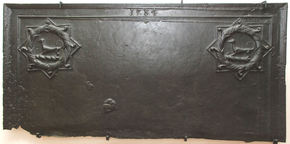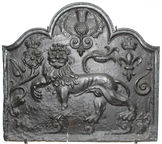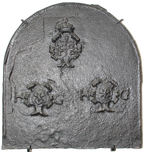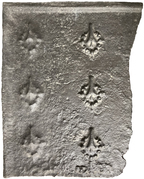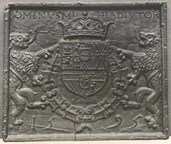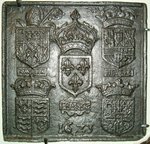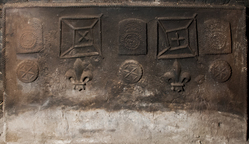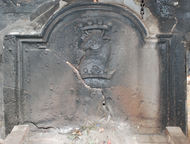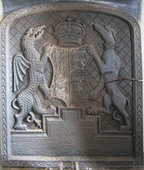-
752
Description: Rectangular; cavetto moulded edging on top and sides, with astragal and fillet inside; talbot crest within wreath and eight-pointed star, repeated at top corners; date top centre between mouldings.
Notes: The crest is probably that of the Parker family, of Ratton, near Eastbourne, Sussex. The base board appears to have been repositioned prior to the wreath stamps being impressed in the mould. Acquired from Marle Green Farm, Hellingly, Sussex, in 1896.
Inscription: 1584
- Decoration tags:
- rectangular (shape)
- carved stamps
- individual numbers
- heraldic
- text
- animals
- objects
Manufactured: in 1584 in the Weald area of England.
Current location: Victoria & Albert Museum, Cromwell Road, Kensington & Chelsea, Greater London, England.
Museum number: 780.1896 (part of the Victoria & Albert Museum museum group)
- Attached to series:
- Royal series
- Royal (wreath) series
-
763
Description: Quasi-Arched rectangular shape with cyma reversa shoulders; ovolo edging; stylised lion passant guardant; crowned rose with leaf and stem on left, crowned fleur de lys on right, thistle with leaves above centre; three right-facing scrolls at base; down-facing scroll, with staple, on right side; date split between bottom corners; initials below date, bottom right.
Notes: Blatantly Royalist in its symbolism, a variant (no. 901) is dated (perhaps more convincingly) 1641. Numeral style, initials, leaf depiction and the stapled scroll are typical features of firebacks made from patterns by the same maker. A later version of the same subject, but with a different shaped plate and without the fleur-de-lys, is also known (see 'Royalist series'). M. A. Lower writes of firebacks of this design of being cast at Waldron Furnace in Sussex (Lower, 1849, p.219).
Copies of this fireback are known.
Inscription: 16 49 / IM
- Decoration tags:
- rectangular with round arch (shape)
- ovolo (edging)
- whole carved pattern
- heraldic
- royal
- text
- animals
Manufactured: in 1649 possibly at Brede Furnace in the Weald area of England.
Current location: Victoria & Albert Museum, Cromwell Road, Kensington & Chelsea, Greater London, England.
Museum number: 492.1901 (part of the Victoria & Albert Museum museum group)
Citation: Lloyd, N., 1925, 'Domestic Ironwork I', Architectural Review, 58, pp. 58-67.
- Attached to series:
- IM series
- Hooked '1' series
- Stapled scroll series
- Brede group
-
767
Description: Arch shaped; rope edging (top and sides); top centre, slightly over-pressed crowned cartouche with initials F S linked with twisted cord; below, two cartouches, each bearing a 7-pointed star, and each separating the paired initials HG.
Notes: The national origin of this fireback is a little uncertain. A variant of this fireback (no. 1306) has slightly different proportions and relative positions of the stamps.
Inscription: F S / H G H G
- Decoration tags:
- rounded arched (shape)
- rope (edging)
- carved stamps
- heraldic
- text
Manufactured: in the 16th century possibly in the Lorraine area of France.
Current location: Victoria & Albert Museum, Cromwell Road, Kensington & Chelsea, Greater London, England.
Museum number: 888.1901 (part of the Victoria & Albert Museum museum group)
- Attached to series:
- Miscellaneous stamp firebacks
- Cord-linked initials firebacks
-
1067
Description: Fragment; rectangular shape; ovolo-moulded edging (top and sides); six stamps, in two columns of three, taking the form of a long-pointed arrow head within a circlet of small curls.
Notes: The stamps are of an unfamiliar type with some similarity to the heraldic symbol for ermine. Because only the left part of the fireback has survived it is not known how many original columns of this stamp there were.
- Decoration tags:
- rectangular (shape)
- ovolo (edging)
- carved stamps
- heraldic
Manufactured: in the 16th century possibly in the Weald area of England.
Current location: Victoria and Albert Museum, Cromwell Road, Kensington and Chelsea, London, England.
Museum number: M.148-1915 (part of the Victoria & Albert Museum museum group)
- Attached to series:
- Miscellaneous stamp firebacks
-
1227
Description: Rectangular shape with ovolo-moulded edging; within the collar of the Order of the Golden Fleece, a central shield of the arms of Spain: quarterly Castile and Leon, Aragon and Aragon-Sicily, with an escutcheon of Portugal; in base Austria, Burgundy ancient, Burgundy modern and Brabant with an escutcheon of Flanders impaling Tyrol; above, a crown; supporters: two golden lions rampant; below the shield, the date, 1595; above the crown, the inscription: Dominus mihi adiutor (the Lord is my helper).
Notes: The arms of King Philip II of Spain following the unification with Portugal, as used in the Spanish Netherlands. Part of the bequest to the Victoria and Albert Museum by Lieut. Colonel G. B. Croft-Lyons in 1926.
Copies of this fireback are known.
Inscription: DOMINVS MIHI ADIVTOR
Arms: King Philip II of Spain (Spanish Netherlands)
- Decoration tags:
- rectangular (shape)
- ovolo (edging)
- whole carved pattern
- heraldic
- armorial
- royal
- text
- animals
Manufactured: in 1595 possibly in the Ardennes area of Belgium.
Current location: Science Museum, Exhibition Road, Kensington & Chelsea, London, England.
Museum number: M.624.1926 (part of the Victoria & Albert Museum museum group)
- Attached to series:
- Foreign armorial firebacks
-
1171
Description: Rectangular shape; fillet edging; arrangement of five shields: centre, arms of the kingdom of France surmounted by a crown and, below, the word FRANCE on a fillet edged rectangular block over a cartouche; top left, arms of the duchy of Lorraine surmounted by a bishop's mitre and crozier separating a largely illegible text; top right, arms of the kingdom of Spain surmounted by a crown with the letters SPA to the left; bottom right, arms of the duchy of Nevers surmounted by a coronet below a fillet edged rectangle with the word NEVERS; bottom left, arms of the kingdom of England surmounted by a crown below a fillet edged rectangle with the word ANGLIA; bottom centre, the date 1623.
Notes: A taque de foyer or takenplatte; the arms in the corners are likely to be of (from top left): Louis III of Lorraine, Archbishop of Reims; King Philip III of Spain; Charles I, Duke of Nevers and Rethel; and Queen Elizabeth I of England. A similar fireback with the same arms, illustrated by von den Driesch (1990, p.181), has the date 1611, but the absence of a cardinal's hat over the arms of Louis of Lorraine suggests that the fireback originally dates from before 1605.
Inscription: [LORR]AI[NE] SPA / ANGLIA NEVERS / FRANCE / 16z3
Arms: Louis of Lorraine; Kingdom of Spain; Kingdom of France; Kingdom of England; Charles Gonzaga, Duke of Nevers
- Decoration tags:
- rectangular (shape)
- fillet (edging)
- whole carved pattern
- individual numbers
- heraldic
- armorial
- royal
- text
Manufactured: in 1623 possibly in the Ardennes area of Belgium.
Current location: Musée Gaumais, 38 Rue d'Arlon, Virton, Luxembourg, Belgium.
(part of the Musée Gaumais, Virton museum group)
- Attached to series:
- Foreign armorial firebacks
-
1276
Description: Rectangular shape; twisted rope edging (top and sides only); along the top, two irregular arrangements of rope lengths forming a small quasi-square within a larger quasi-square, with the outer corners of the small square joined to the inner corners of the larger square, a short length of rope extending outwards from the top and bottom right corners of the larger square, and within the left small square a rope saltire, and in the right small square a rope cross; between and outside of these rope arrangements, an arched rectangular stamp, with indented edges, of a crowned rose-en-soleil impressed three times; below each rope pattern a fleur-de-lys; below each rose-en-soleil stamp, a circular, six-pointed-star-embossed stamp with beaded edging.
Notes: All of the stamps have been noted on a series of other firebacks together with variations of the rope arrangement. The clarity of the condition of the stamps suggests that this casting predates the others in the series.
- Decoration tags:
- rectangular (shape)
- rope (edging)
- simple stamps
- carved stamps
- heraldic
- royal
- objects
Manufactured: in the mid- to late-16th century possibly at Pounsley Furnace, Framfield in the Weald area of England.
Current location: in private hands, Wadhurst, East Sussex, England.
- Attached to series:
- Pounsley series
- Rose-en-soleil series
- Food mould stamp firebacks
-
778
Description: Arched rectangular shape; cavetto/cyma recta moulded edging; plain rectangular panels at sides; top centre, bull’s head and neck issuing from a marquesal coronet, a baronial coronet above.
Notes: The crest of the Barons Bergavenny, although it should issue from a ducal, rather than a marchesal, coronet, and the rose normally placed on the neck is missing. The carved crest was affixed to a board of similar shape but smaller dimensions to the board with the moulded edging, indicating that the moulded board could have been used for other firebacks. Believed to have formerly been at Maresfield Park, Sussex.
- Decoration tags:
- rectangular with round arch (shape)
- complex individual (edging)
- carved stamps
- carved pattern panels
- extension panels
- heraldic
Manufactured: in the early-18th century in the Weald area of England.
Current location: in private hands, Waldron, East Sussex, England.
- Attached to series:
- Bergavenny firebacks
-
1246
Description: Low-arched shape within broad fillet edging marked with a repeated leaf pattern ascending toward the top; on an incised criss-cross field a Tudor royal shield, quarterly France Modern and England, supported by a stylised, scaly dragon and greyhound and surmounted by a crown, all resting on a two-stepped compartment with cavetto- and astragal-moulded edging at the top.
Notes: Pastiche 'Tudor' design by George Shaw of Saddleworth, Lancashire, c.1850, possibly intended to be passed off as genuine Tudor. Another casting in this form is in Cheetham's Library, Manchester. A variant exists without the leaf pattern on the edging and the 'scales' on the dragon. Firebacks of the same armorial design within a different, arched rectangular, edging are also known.
Copies of this fireback are known.
Arms: Tudor royal
- Decoration tags:
- rounded arched (shape)
- custom with repeated leaf pattern (edging)
- whole carved pattern
- heraldic
- armorial
- royal
Manufactured: in the mid-19th century possibly in the Lancashire area of England.
Current location: Warkworth Castle, Warkworth, Northumberland, England.
(part of the English Heritage museum group)
- Attached to series:
- Tudor royal armorial firebacks
- George Shaw series
-
1106
Description: Arched rectangular shape with quadrant extensions on top corners; twisted rope edging (top and sides); vertical rope line parallel to each side, forming two separate side panels; horizontal rope line joined to vertical lines enclosing the following: inside arch, initials IBA in triad; below initials, double fleur-de-lys stamp between split date 1693; below horizontal line, a double fleur stamp in each top corner of central lower panel; in each side panel, a single bead above a vertical sequence of squared cross stamps repeated nine times.
Notes: The distinctive squared cross and fleur stamps are seen on other firebacks; the initials in triad may relate to a husband and wife. The photograph had to be taken through a perspex sheet marked with bird droppings.
Inscription: IBA [triad] / 16 93
- Decoration tags:
- rectangular with round arch (shape)
- rope (edging)
- carved stamps
- individual letters
- individual numbers
- heraldic
- text
- objects
Manufactured: in 1693 in the Forest of Dean area of England.
Current location: Northgate House, Northgate, Warwick, Warwickshire, England.
- Attached to series:
- Newent area group
- Date & initials firebacks
- Square cross Dean series 2
